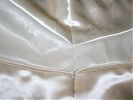With the seams (mostly) constructed and all the seam allowances tacked down, it was time for the boning! Bridal Couture assumes that you’ve got a fairly standard princess-seamed bodice and so advises that you sew the channels to the centre of the underlining pieces at the very beginning before attaching the underlining to the fashion fabric. But my bodice has all sorts of crazy seams and the boning crosses over a bunch of seamlines, so I had to obviously apply my channels after the main seams were stitched, as Susan Khalje advises in this Threads article.
I was originally thinking to make my own channels with silk organza, but then I saw that the Sewing Chest had pre-made and seam-free cotton channels so I bought those and ended up going with that instead to save myself some time. And as Ms Khalje talks about using them herself, I figured it’s okay!
So I started a production line – first I sewed the end of the channel closed with the sewing machine, then I carefully pinned the channel to the bodice underlining where it was needed, then cut the end just before the seamline at the bottom of the bodice. Once all the channels were in place, I then catchstitched them all to the flannel underlining, keeping the bottom free to insert the boning.
Here you can see all the channels, minus the one going on the zipper tape (to be attached after the zipper is in place):
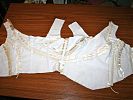
Details of all that catchstitching… I’m going through the ivory silk thread at an alarming rate!
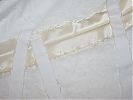
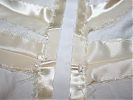
And here’s the correct side of that side seam seen above. I’m quite proud of my seam matching!
After the photos were taken and the channels were in, I sewed the shoulder seams and catchstittched those allowances, too, so I could get a feel for the fit with the boning in place.
This was my first time working with spiral steel boning, but it won’t be the last! It’s cheap, super flexible in 360 degrees, and not stiff or curved in the slightest like the covered plastic boning. And because you’re dealing with channels, you can remove the boning while you’re working on the garment and just pop them in at the last second. If you’ve ever worked with boning of any type, you know how a garment takes on a life of its own once the boning is attached and you’re wrestling to get it under the machine!
You can buy spiral steel boning in pre-cut lengths, but none of these lengths matched what I actually needed so would have to be cut down. So instead I opted instead to buy it in one continuous length so I wouldn’t have any waste, and I could trim and cap it as I liked.
How to cut spiral steel boning
Gather your materials – spiral steel boning, end caps (two for each length of boning in the same width as your boning!), needlenose pliers, and wire cutters.
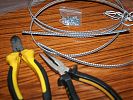
Using the wire cutters, snip through just one wire on one side. Do NOT cut across the whole boning! If your cutters are anything like mine, it may not cut the whole way through so you may need to twist and bend it til it snaps at the weak spot you’ve just made…
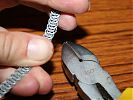
Snip the wire on the other side from your first cut…
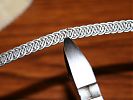
Pull the sides apart, and grab an end cap…
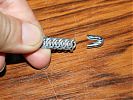
Put the end cap over the end of your boning and squeeze the sides of the end cap with pliers to make it tight.
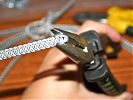
Put an end cap on the other end and your boning is finished and ready for insertion!
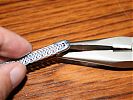
Oh and in other news, we had a bit of a London sewing blogger mini-meetup yesterday afternoon for the Fashion & Textile Museum‘s Horrockses exhibit. Karen from Did You Make That?, Susannah from Cargo Cult Craft, and Tilly of “…and the Buttons” fame all joined me in a bunch of vintage dress drooling on a Sunday afternoon, and much fun was had by all. I was most impressed by all the wonderful vintage prints that wouldn’t be out of place in Ikea’s textile department today, though the construction details of the dresses themselves weren’t particularly original (but hey, it was RTW, not couture, so what do you expect?). Anyway, Tilly’s got some great photos up already so I don’t feel bad about not taking any myself!
Next up on the dress: clipping, turning, pressing, and catchstitching the neckline and armhole edges…

